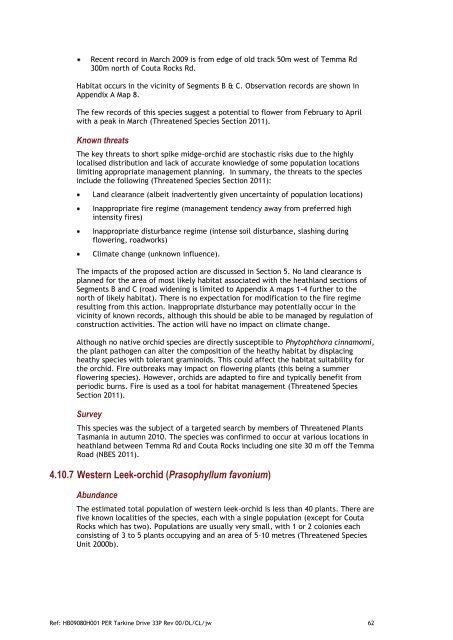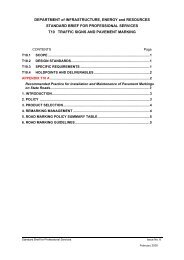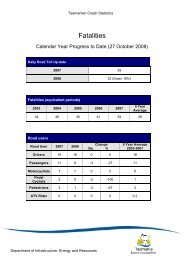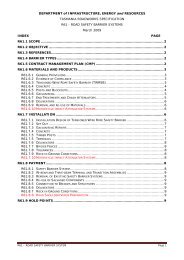Public Environment Report Tarkine Forest Drive ... - Transport
Public Environment Report Tarkine Forest Drive ... - Transport
Public Environment Report Tarkine Forest Drive ... - Transport
- No tags were found...
You also want an ePaper? Increase the reach of your titles
YUMPU automatically turns print PDFs into web optimized ePapers that Google loves.
Recent record in March 2009 is from edge of old track 50m west of Temma Rd300m north of Couta Rocks Rd.Habitat occurs in the vicinity of Segments B & C. Observation records are shown inAppendix A Map 8.The few records of this species suggest a potential to flower from February to Aprilwith a peak in March (Threatened Species Section 2011).Known threatsThe key threats to short spike midge-orchid are stochastic risks due to the highlylocalised distribution and lack of accurate knowledge of some population locationslimiting appropriate management planning. In summary, the threats to the speciesinclude the following (Threatened Species Section 2011):Land clearance (albeit inadvertently given uncertainty of population locations)Inappropriate fire regime (management tendency away from preferred highintensity fires)Inappropriate disturbance regime (intense soil disturbance, slashing duringflowering, roadworks)Climate change (unknown influence).The impacts of the proposed action are discussed in Section 5. No land clearance isplanned for the area of most likely habitat associated with the heathland sections ofSegments B and C (road widening is limited to Appendix A maps 1-4 further to thenorth of likely habitat). There is no expectation for modification to the fire regimeresulting from this action. Inappropriate disturbance may potentially occur in thevicinity of known records, although this should be able to be managed by regulation ofconstruction activities. The action will have no impact on climate change.Although no native orchid species are directly susceptible to Phytophthora cinnamomi,the plant pathogen can alter the composition of the heathy habitat by displacingheathy species with tolerant graminoids. This could affect the habitat suitability forthe orchid. Fire outbreaks may impact on flowering plants (this being a summerflowering species). However, orchids are adapted to fire and typically benefit fromperiodic burns. Fire is used as a tool for habitat management (Threatened SpeciesSection 2011).SurveyThis species was the subject of a targeted search by members of Threatened PlantsTasmania in autumn 2010. The species was confirmed to occur at various locations inheathland between Temma Rd and Couta Rocks including one site 30 m off the TemmaRoad (NBES 2011).4.10.7 Western Leek-orchid (Prasophyllum favonium)AbundanceThe estimated total population of western leek-orchid is less than 40 plants. There arefive known localities of the species, each with a single population (except for CoutaRocks which has two). Populations are usually very small, with 1 or 2 colonies eachconsisting of 3 to 5 plants occupying and an area of 5–10 metres (Threatened SpeciesUnit 2000b).Ref: HB09080H001 PER <strong>Tarkine</strong> <strong>Drive</strong> 33P Rev 00/DL/CL/jw 62
















